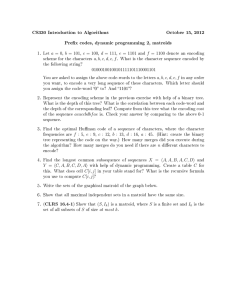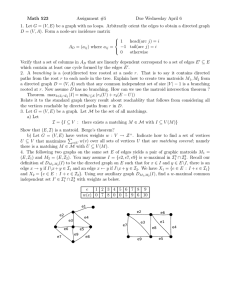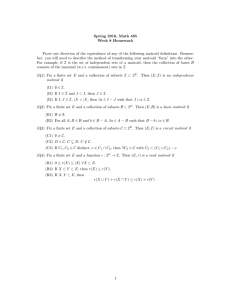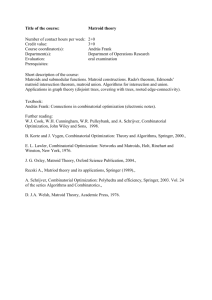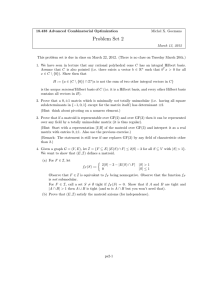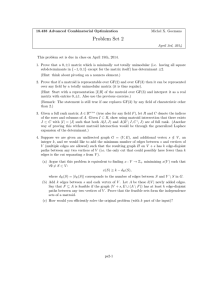Lecture 11
advertisement
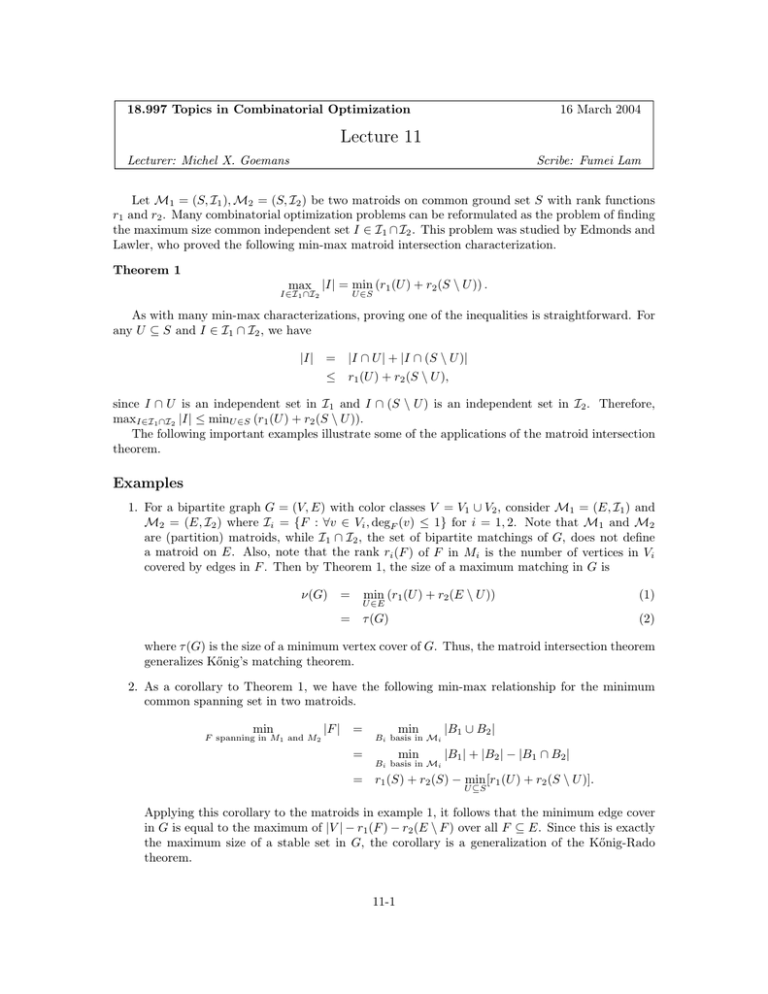
18.997 Topics in Combinatorial Optimization
16 March 2004
Lecture 11
Lecturer: Michel X. Goemans
Scribe: Fumei Lam
Let M1 = (S, I1 ), M2 = (S, I2 ) be two matroids on common ground set S with rank functions
r1 and r2 . Many combinatorial optimization problems can be reformulated as the problem of finding
the maximum size common independent set I ∈ I1 ∩ I2 . This problem was studied by Edmonds and
Lawler, who proved the following min-max matroid intersection characterization.
Theorem 1
max |I| = min (r1 (U ) + r2 (S \ U )) .
I∈I1 ∩I2
U∈S
As with many min-max characterizations, proving one of the inequalities is straightforward. For
any U ⊆ S and I ∈ I1 ∩ I2 , we have
|I| =
≤
|I ∩ U | + |I ∩ (S \ U )|
r1 (U ) + r2 (S \ U ),
since I ∩ U is an independent set in I1 and I ∩ (S \ U ) is an independent set in I2 . Therefore,
maxI∈I1 ∩I2 |I| ≤ minU∈S (r1 (U ) + r2 (S \ U )).
The following important examples illustrate some of the applications of the matroid intersection
theorem.
Examples
1. For a bipartite graph G = (V, E) with color classes V = V1 ∪ V2 , consider M1 = (E, I1 ) and
M2 = (E, I2 ) where Ii = {F : ∀v ∈ Vi , degF (v) ≤ 1} for i = 1, 2. Note that M1 and M2
are (partition) matroids, while I1 ∩ I2 , the set of bipartite matchings of G, does not define
a matroid on E. Also, note that the rank ri (F ) of F in Mi is the number of vertices in Vi
covered by edges in F . Then by Theorem 1, the size of a maximum matching in G is
ν(G)
=
min (r1 (U ) + r2 (E \ U ))
(1)
τ (G)
(2)
U∈E
=
where τ (G) is the size of a minimum vertex cover of G. Thus, the matroid intersection theorem
generalizes Kőnig’s matching theorem.
2. As a corollary to Theorem 1, we have the following min-max relationship for the minimum
common spanning set in two matroids.
min
F spanning in M1 and M2
|F |
=
=
min
|B1 ∪ B2 |
min
|B1 | + |B2 | − |B1 ∩ B2 |
Bi basis in Mi
Bi basis in Mi
= r1 (S) + r2 (S) − min[r1 (U ) + r2 (S \ U )].
U⊆S
Applying this corollary to the matroids in example 1, it follows that the minimum edge cover
in G is equal to the maximum of |V | − r1 (F ) − r2 (E \ F ) over all F ⊆ E. Since this is exactly
the maximum size of a stable set in G, the corollary is a generalization of the Kőnig-Rado
theorem.
11-1
3. Consider a graph G with a k-coloring on the edges, i.e., edge set E is partitioned into color
classes E1 ∪ E2 ∪ . . . ∪ Ek . The question of whether or not there exists a rainbow spanning tree
(i.e. a spanning tree with edges of different colors) can be restated as a matroid intersection
problem on M1 = (E, I1 ) and M2 = (E, I2 ) with
I1
I2
=
=
{F ⊆ E : F is acyclic}
{F ⊆ E : |F ∩ Ei | ≤ 1 ∀i}
Since I1 ∩ I2 is the set of rainbow forests, there is a rainbow spanning tree of G if and only if
max |I| = |V | − 1.
I∈I1 ∩I2
By Theorem 1, this is equivalent to the condition
min (r1 (U ) + r2 (E \ U )) = |V | − 1.
U⊆E
Since r1 (U ) = |V | − c(U ) (where c(U ) denotes the number of connected components of (V, U )),
it follows that there is a rainbow spanning tree of G if and only if the number of colors in E \ U
is at least c(U ) − 1 for any subset U ⊆ E. In other words, a rainbow spanning tree exists if
and only if removing the edges of any t colors leaves a graph with at most t + 1 components.
4. Given a digraph G = (V, A), a branching D is a subset of arcs such that
(a) D has no directed cycles
(b) For every vertex v, degin (v) ≤ 1 in D.
Branchings are the common independent sets of matroids M1 = (E, I1 ), M2 = (E, I2 ), where
I1
= {F ⊆ E : F is acyclic in the underlying undirected graph G}
I2
= {F ⊆ E : degin (v) ≤ 1 ∀v ∈ V }
Note that M1 is a graphic matroid on G and M2 is a partition matroid. Therefore, the
problem of finding a maximum branching of a digraph can be solved by the matroid intersection
algorithm.
In order to prove Theorem 1, we need the following lemmas. Recall that a circuit is a minimal
dependent set.
Lemma 2 Let M = (S, I) be a matroid. If I ∈ I, I + x ∈
I, then I + x contains a unique minimal
circuit.
Lemma 3 (Basis exchange) Suppose B1 and B2 are two bases of a matroid M. For any x ∈ B1 \B2 ,
there exists y ∈ B2 \ B1 such that
B1 − x + y ∈ I and B2 − y + x ∈ I
Given an independent set I in a matroid M = (S, I), we define a digraph with vertex set S
and arc set AM (I) = {(x, y) : x ∈ I, y ∈ S \ I, I − x + y ∈ I}. We often drop the M subscript
when referring to A. This digraph plays a crucial role in several matroid optimization algorithms
including matroid intersection.
Lemma 4 Let I, J ∈ I with |I| = |J|. Then A(I) contains a matching on I∆J = (I \ J) ∪ (J \ I).
11-2
Proof: We can assume I, J are bases in I (otherwise, consider the truncated matroid whose
independent sets are those in I of size less than or equal to |I|). We proceed by induction on |I \ J|.
For any x ∈ I \ J, there exists y ∈ J \ I such that J = J − y + x ∈ I. Then I \ J = (I \ J) − x and
J \ I = (J \ I) − y. If |I \ J| = 1, then we are done; otherwise by induction on |I \ J|, A(I) contains
a matching on I∆J , which we extend to a matching of I∆J by adding edge (x, y).
�
Unfortunately, the converse of this theorem is not true, as shown by the following counterexample.
Let M be the graphic matroid on the following graph G.
e1
e2
f2
e3
f1
For I = {e1 , e2 , e3 }, J = {f1 , f2 , e3 }, A(I) contains a matching (e1 , f1 ), (e2 , f2 ) of I∆J and I ∈ I,
but J ∈ I.
However, by a slight strengthening of the condition, we can prove the following.
Lemma 5 Given matroid M = (S, I), I ∈ I, and J ⊆ S with |I| = |J|, if A(I) contains a unique
matching on I∆J, then J ∈ I.
Note that in the example above, A(I) also contains the matching (e1 , f2 ), (e2 , f1 ) on I∆J, so the
stronger condition fails.
Proof: Let N denote the unique perfect matching on I∆J and consider the digraph in which we
reverse the orientation of the arcs in N . By the uniqueness of the perfect matching, there are no
directed cycles in the resulting graph, so there is a topological ordering of the vertices. This ordering
induces a labeling on vertices in N = {(y1 , z1 ), (y2 , z2 ), . . . (yt , zt )} such that there are no arcs (yi , zj )
for i < j.
If J ∈ I, then it contains a circuit C. Let i be the smallest index such that zi ∈ C. Since there
are no arcs from yi to zj with j > i, I − yi + zj ∈ I, implying zj ∈ span(I − yi ). Since this is true
for all j > i, C − zi ⊆ span(I − yi ). But since C is a circuit, zi ∈ span(C − zi ) ⊆ span(I − yi ). Then
I − yi + zi ∈ I and by definition of A(I), (yi , zi ) ∈ A(I) (since I − yi + zi ∈ I), a contradiction to
the existence of perfect matching N . Therefore J ∈ I.
�
Now, we state the matroid intersection algorithm, whose proof we will give in the next lecture.
Since I may be exponential in size, we assume our matroid is described by an oracle which, given
I ⊆ S, can determine in polynomial time if I ∈ I. Then the running time of the algorithm is
polynomial in the number of calls to the oracle.
First, for I ⊆ S, define the digraph D(I) = (S, A) as follows: for y ∈ I, x ∈
/ I, we have an arc
(y, x) ∈ A if I − y + x ∈ I1 and (x, y) ∈ A if I − y + x ∈ I2 . This is the union of the arcset AM1 (I)
corresponding to I1 and the reverse of the arcset AM2 (I) corresponding to I2 . Consider the sets
X1 = {x ∈ S \ I : I + x ∈ I1 }, X2 = {x ∈ S \ I : I + x ∈ I2 }.
Matroid Intersection Algorithm
Input Matroids M1 = (S, I1 ), M2 = (S, I2 )
Output I ∈ I1 ∩ I2 of maximum size
I←∅
while D(I) has a path from X1 to X2
I ← I∆V (P ), where P is a shortest path from X1 to X2 .
We will prove the correctness of this algorithm in the next lecture.
11-3
